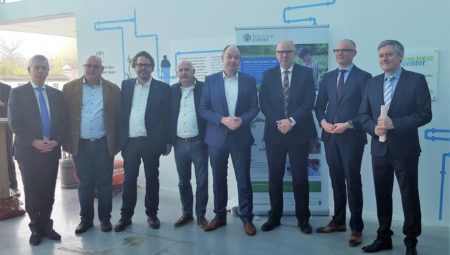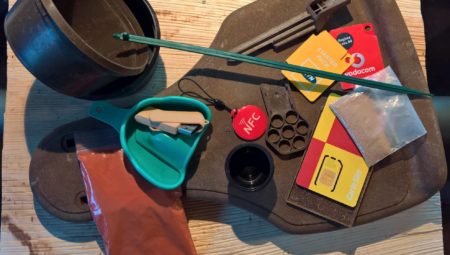The past few years have seen structural research performed on plant components from Dutch horticulture and agriculture for high-end applications in the food, pharmaceutical and cosmetic industries. How far have we got? ‘Experiments currently underway concentrate particularly on drop-in products to replace chemical building blocks and improve the quality and quantity of plant components by optimising cultivation,’ says Jolanda Heistek, programme manager at Greenport Westland-Oostland. Leon Mur, director of the Dutch Centre of Expertise for Plant Compounds (Kenniscentrum Plantenstoffen), also sees opportunities in the development of new, innovative molecules. ‘The Dutch Centre of Expertise for Plant Compounds is directed especially towards new bioactive ingredients; molecules with a specific effect such as antibiotics, anti-wrinkle effects for cosmetic applications or crop protection against pests.’
Abundance
There are thousands of plant components in plants. ‘And we certainly have more than enough plants in the Netherlands,’ says Heistek. ‘There is an abundance of knowledge as well as enough greenhouses.’ Nor is the market the problem, believes Mur: ‘More and more often the consumer wants natural ingredients and fewer preservatives. The big companies are responding to this. Moreover, nature can supply substances that cannot be produced from oil. These are of particular interest to the industry. It is a unique position for the agricultural sector to make use of.’ Plant components can also offer ‘green’ alternatives for chemical raw materials. ‘For instance, biobased substances with antimicrobial activity can be added to food, and this can greatly reduce the amount of added salt and sugar,’ says Heistek. ‘The components in a plant can reinforce each other in some cases. That is why they have greater effect in a plant extract than an isolated or synthetically produced substance,’ adds Eric Poot, team leader at Wageningen UR Greenhouse Horticulture.
Long lead time
Experts from the sector believe there are currently good opportunities for the Dutch horticulture and agriculture to create added value from plant components and strengthen the Dutch economy. But specific applications have yet to appear. What is still holding up the development?
Poot: ‘The pharmaceutical industry in particular, but also food and crop protection products require significant investment and these projects have a long lead time. This is because many tests have to be carried out before they satisfy all laws and regulations.’ That does not come as a surprise, according to Marlon Pijpelink, project manager at Biobased Economy, Impuls Zeeland. ‘It also took the traditional oil-based industry decades of development to get to where they are now.’
Rusthoeve
‘The processing industry does not possess enough knowledge about what plant components can mean,’ states Heistek. It could therefore be a valuable exercise for the horticultural and agricultural sector to present potentially interesting crops to customers. One example is the Biobased Innovation Garden Rusthoeve project, which mainly targets agricultural crops from the Biobased Delta with possible new potential (e.g. oil-bearing grain for fatty acids/fine chemicals, other crops for biocides, colouring and flavouring, building materials, etc). ‘By growing the crops in a garden at the De Rusthoeve test farm, we can gain experience in the cultivation of new crops and inspire parties for these possibilities. One of the ways we do that is by holding “inspiration sessions”, where we help different parties connect,’ says Pijpelink. Wageningen UR also acts as an idea box. Poot: ‘In the Greenhouse Pharmacy programme we optimise the cultivation of a selection of plants with high potential in our greenhouses and present them to horticulturalists and market parties. We will develop the plant that attracts the most interest into a business case.’
Accelerating development
Besides showcasing interesting crops, Poot believes there are other ways for the horticultural sector to speed up the development of plant components. ‘The sector and the State have currently entered into a Green Deal, to get green crop protection products on the market faster. The horticultural sector can influence itself on these kinds of deals itself.’ Mur thinks that the agricultural sector itself must invest if it wants to take up its own position and create value. According to Poot the opportunities are currently to be found in serving niche markets with new high-end applications for plant components.
Heistek agrees with him. ‘We are going through a transitional phase right now. It is very important to take decisions now and show breakthroughs. In the Biobased programme of Greenport Westland-Oostland, together with Greenport Aalsmeer and the Centre of Expertise for Plant Compounds, we have chosen seven business cases that we will put on the market.’
Scaling up
There are still some hurdles to be taken to scale up the extraction process. ‘A lengthy process of laboratory tests, pilots and demos needs to be completed before a plant component can be used in larger applications. We also need large equipment for a few business cases. That means large investments,’ says Pijpelink. ‘These investments will only be made if people are very certain that everything works. The risks are currently still too large.’ Heistek also understands that entrepreneurs or horticulturalists cannot take on all the risks on their own: ‘Cooperation means sharing risks. Initiatives like Greenport Westland-Oostland have to support that cooperation.’ Scaling up also creates a number of logistical issues. You can only store biomass for a short period. And in the context of sustainability it is not sensible to transport plant material long distances. ‘That only makes everything more expensive,’ says Mur.
Different language
Heistek believes that business development is the most important step now in order to make the transition from knowledge to the market. Mur emphasises: ‘If we want to succeed, the entire value chain has to be organised from start to finish.’ According to Pijpelink, this is not an easy task either: ‘Parties from the different sectors often don’t speak each other’s language, they don’t have a clear picture of the process, they don’t assess the risks and that is why they drop out.’
Heistek: ‘If we succeed in bringing the processing industry and the horticultural sector together, we can make considerable headway. Market parties have shown interest in all our projects and the scientific proof of the feasibility of the projects is there. A last requirement is that entrepreneurs are closely involved in the projects, on the production and the market sides.’ Pijpelink: ‘Impuls Zeeland also emphatically encourages the selling parties and the supply side, and the entire supply chain in between, to become involved in the development of new products, so that it goes further than just development and a market is actually created.’
Golden bullet
‘It just takes a lot of time,’ thinks Mur. ‘But we now have an extract library with raw and cleaned extracts from around 1,200 plants grown on a commercial basis. Of course, it is no golden bullet, but we do have something tangible in our hands that connects the horticultural sector and industry. Other parties also concur with this. The extract library generates funds for research and creates knowledge for valorisation. The innovations that arise in turn create new business. That is the current impact of the library, on a national but also international level. Currently we are working with companies like L’Oréal to see how they can use the extract library for screening, for instance for anti-ageing compounds or skin-whitening substances.’
It is all becoming increasingly more tangible, so that breakthrough will definitely be made, asserts Heistek. ‘A number of the current projects, like Nedervanille (see box), are now at the turning point and almost ready to go to market.’ A little more patience, that is the drift of the above experts: the market-mature products are on their way.
Nedervanille
‘Nedervanille’ is a public-private cooperation project in which growers, Wageningen UR, University of Applied Sciences Leiden and other partners have been working together since 2014 on biological vanilla from Dutch glasshouse horticulture. Vanilla is of course well known as a spice for the food industry. The plant also contains the component ‘vanillin’, which is active as a medicine against things like thrush and athlete’s foot.
Vanilla comes from the vanilla orchid, which is endemic to areas with a hot climate, like Africa and Mexico. Although glasshouse horticulture is more expensive than growing in open ground, it offers the producer of plant components many advantages that can even up the differences in investment. Crops like the vanilla plant can be cultivated in Dutch greenhouses, regardless of the external climate conditions and without expensive transport costs. The quality and purity of the plant components can be guaranteed. Moreover, production in greenhouses is guaranteed, and sometimes it is possible to harvest several times a year. The crop is also cleaner because no pesticides are used. Eric Poot: ‘We are encountering all kinds of interesting challenges in growing a new plant like vanilla under glass. In nature, the plant is pollinated by the melipona bee, which leads a solitary life. This bee cannot survive in greenhouses. We are now working in various disciplines to find the best possible alternative from nature or using technology.’



